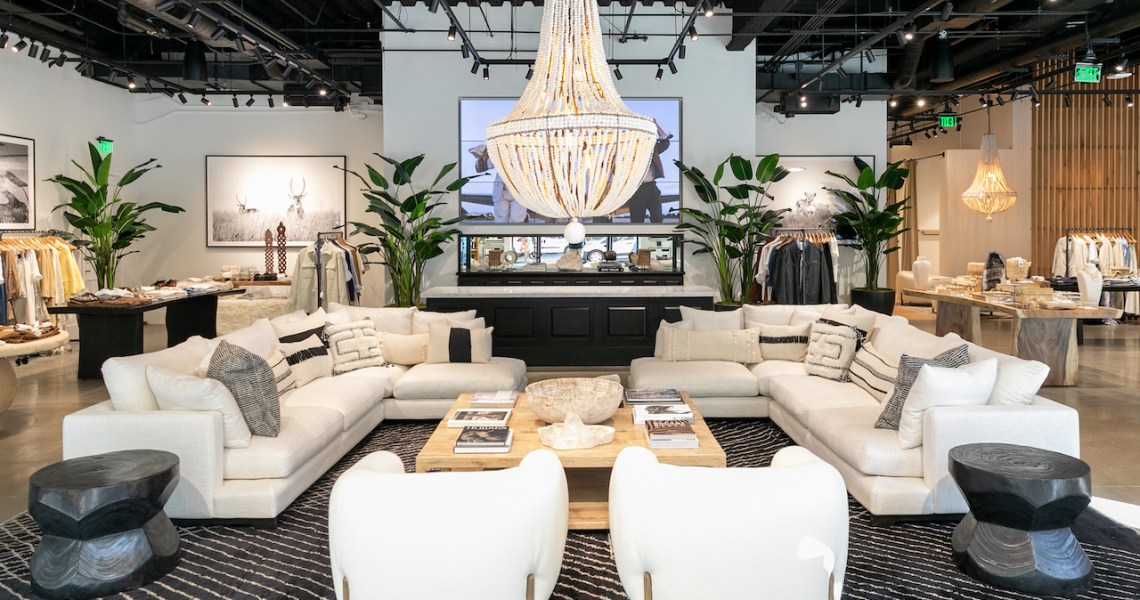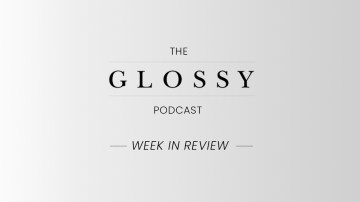This week, an exploration of the physical effects of Banana Republic’s recent rebranding. Scroll down to use Glossy+ Comments, giving the Glossy+ community the opportunity to join discussions around industry topics.
Even as the definition of luxury evolves, it’s safe to state that a luxury shopping experience can be found on NYC’s Fifth Avenue. What’s less obvious is that Gap Inc. chain Banana Republic is behind a strong example.
The Flatiron-store direction
The retailer’s Flatiron store, located on 18th Street and Fifth, is among the best physical representations of its new direction, according to a company representative. Modern, yet inviting, and designed to appeal to the senses, the shop bears more similarities to a high-end department store than a cookie-cutter mall destination. That’s despite the 45-year-old retailer’s roots and extensive physical footprint.
At the center of the two-story space’s first floor is a lounge area, complete with soft seating, a beaded chandelier and wooden coffee tables topped with books by Architectural Digest and Dior. To its left is an expanding home department, currently made up of throws and pillows selling for up to $350. That’s surrounded by a bar, regularly offering cocktails and champagne; a well-trafficked jewelry table, featuring the assortment that relaunched last year; and a women’s ready-to-wear section, housing classic cargo pants, utility vests and safari shirting. The section’s clothing reflects the company’s renewed focus on its adventure-centered heritage. The same can be said of the oversized framed photographs of African landscapes hanging overhead. They’re from the company’s Art line, introduced in November.
Deeper into the store, shoppers can find BR Baby, a 10-month-old collection of cashmere onesies and leather flight jackets for kids up to 2-years-old. Women’s shoes and handbags, refreshed in September with Italian suedes and leathers, are found in an adjacent section peppered with seasonal, statement apparel styles. A $250 ostrich-feather top and $450 gold-metallic leather shorts are currently selling for holiday. A sale section is confined to a closet-size room in a back corner.
Men’s fashions make up much of the top floor, with the exception of a central, fishbowl-like room allowing shoppers to view tailors at work. The Flatiron location is one of a handful of Banana Republics offering complimentary tailoring for store purchases.
According to Sandra Stangl, president and CEO of Banana Republic since late 2020, the company “aspires to … make shopping at Banana Republic differentiated and exceptional.” In stores, that involves appealing to all the senses, with “natural fragrances from around the world” and music reminiscent of “a chic place you’ve been or a faraway land.”
The floor’s merchandising intentionally “suggests outfit ideas,” she said. For those needing more support, the company has Atelier, its appointment-based personalized styling service that expanded to all of its stores in September.
Overall, the Flatiron store’s makeover plays into Banana Republic’s New Look, a buzzy 2021 rebrand spearheaded by Stangl and former chief brand officer Ana Andjelic. Repositioning Banana Republic, as a “premier lifestyle brand focused on accessible and inclusive luxury,” as Stangl describes it, is at the core. The new stores are complemented by an updated website full of large, full-bleed imagery and editorial videos set in picturesque locations, reminiscent of marketing by Ralph Lauren.
Thus far, the changes have proven successful. Gap Inc.’s third-quarter earnings, released in mid-November, showed Banana Republic’s sales increased 8% year-over-year, making it a standout among Gap Inc. brands. Sales of Athleta and Old Navy, the parent company’s long-time stars, grew by 6% and 2%, respectively. Banana Republic drove Gap Inc.’s revenue in the prior two quarters, too, seeing an even greater difference in its growth percentage, compared to its sister brands. It’s worth noting that Banana Republic drives just one-fourth of Old Navy’s sales. Also noteworthy is that Gap, which reported flat revenue, parted ways with Kanye West during the quarter.
The evolution of the physical footprint
While the Flatiron store boasts the “ideal” Banana Republic shopping experience, the company’s other stores are actively being zhooshed. Reducing product density, creating “clear product narratives” and offering more outfit-creating assistance, while mirroring the brand’s digital presence, defines the way forward for stores, according to a Banana Republic representative.
Banana Republic isn’t the only Gap Inc. brand making changes to its physical presence. In fall 2020, the company announced plans to close 350 Gap and Banana Republic locations across North America by the end of 2023, citing the goal of owning a “healthier fleet of stores.” By the end of 2022, it will be 90% there, per the company.
Across brands, Gap Inc.’s in-store sales increased 1% year-over-year in the third quarter, while making up 61% of total sales. Just 17% of sales were made in indoor malls, with the bulk of earnings made via strip and lifestyle centers. Gap Inc. doesn’t break out its individual brands’ sales by channel.
The introduction of personal styling
Of course, top-notch customer service is key to nailing the in-store shopping experience. For Banana Republic, the newly-rolled-out Atelier was established to perfect that play, providing a more personalized means of serving customers. It incorporates traditional clienteling processes formerly restricted to luxury shoppers, including one-on-one styling sessions offered in-store or online. Forty-five-minute appointments with a stylist can be booked on the brand’s website by any shopper completing a questionnaire about their sizing and shopping purpose.
Banana Republic is taking care to ensure its Atelier stylists have the experience to drive home the concept. For example, Susanne Taussig, Atelier manager at the Banana Republic store in Des Peres, Missouri, formerly worked on the floors of Hermès, Loro Piana and Prada.
Taussig said, for her, a typical Atelier experience involves connecting with the client ahead of the appointment to inquire about their “vision” for the look they’re shopping. Based on information gathered, she’ll set up a personalized rack of around eight outfits, with pieces that can be mixed and matched. She’ll also equip their fitting room with complementary accessories. Checking clients’ coats and offering them refreshments throughout the appointment are standard.
In supporting her clients — many of which have become regulars and include men, as well as women — Taussig often spotlights pieces’ luxury fabrics in describing them. For example, she’ll recommend a “merino-wool sweater” or a “silk-charmeuse blouse.” And, where pertinent, she’ll drop a mention that a style, like Banana Republic’s suiting, has recently experienced a glow-up. Pulling additional options from the store, based on how clients feel in her original selects, is common. And she often tweaks a tried-on look by adding a belt or a statement necklace.
“I love the unexpected — taking [clients] out of their comfort zone and giving them something new,” Taussig said. She noted that Banana Republic’s “luxury direction” attracted her to the company.
As a rule, Taussig doesn’t book back-to-back appointments to ensure all focus is on one client. Typically, her styling sessions go long, averaging an hour. She’s sure to follow up by text or email to thank the shopper and further “foster a relationship,” she said. Ongoing communication is always with a purpose, like to suggest a new style based on past purchases or provide best wishes around a holiday.
Other fashion stores birthed during malls’ heyday have made related moves to attract quality workers and improve customer touchpoints. For example, in step with overhauling its own store footprint, Express has promoted “associates” to “stylists.” And Macy’s has introduced personal styling appointments.
“We’re aiming to change the perception of the brand,” said Stangl, recalling a time in the ’90s when she considered Banana Republic to be “cool and relevant.”
“The brand lost its way over the past decade,” she said. “But [now] we’re bringing new customers in, while serving existing customers in fresh and creative ways. And legacy customers … are coming back.”
And “our physical expression is integral to our business,” she said.
Inside our coverage
Pete Nordstrom on loyalty: ‘Being helpful and kind to customers pays off’
Nike retailer partnerships show it hasn’t given up on wholesale yet
As China reopens, fashion and beauty brands can prepare to regain sales
Want to discuss this with our editors and members? Join here, or log in here if you're already a member.




